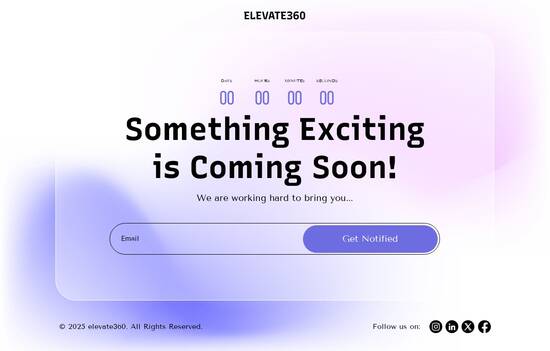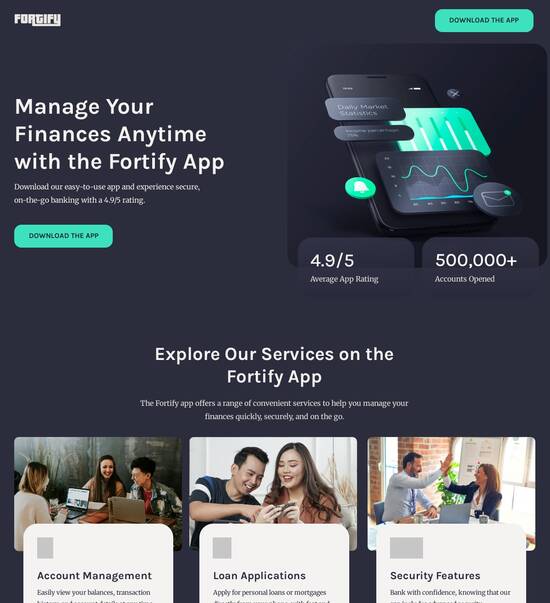
Javascript optimized 403 forbidden page template
Explore Similar TemplatesAbout template
Supercharge your 403 forbidden page with Javascript for outstanding performance! Learn more today.
Recommended templates

Easy to build without coding
With the intuitive drag-and-drop builder, anyone on your team can create high-converting pages without any knowledge of code or design. Make enhancements to your landing page with custom widgets using Javascript, HTML/CSS, or third-party scripts.

Multiple layouts for any industry and goal
Select from 500+ landing page layouts built to boost conversions across industry-specific scenarios. Customize them by adjusting fonts, adding images, and generating on-brand content with the AI assistant. Quickly scale with Instablocks® and Global Blocks that you can save, reuse, and update globally.

Loads fast and looks polished on any device
Every template is responsive, which means they present professionally on any device and load blazingly fast with our Thor Render Engine. You can also power them up with Google AMP technology to deliver an unparalleled mobile experience and drive higher conversions.

Robust analytics & experimentation
Get real-time updates and reporting across all your devices, showing the number of visitors, conversions, cost-per-visitor, and cost-per-lead. Launch AI-powered experiments, run A/B tests, and use heatmaps to analyze user behavior, then optimize your landing page to maximize conversions.







Easy to build without coding
With the intuitive drag-and-drop builder, anyone on your team can create high-converting pages without any knowledge of code or design. Make enhancements to your landing page with custom widgets using Javascript, HTML/CSS, or third-party scripts.
Multiple layouts for any industry and goal
Select from 500+ landing page layouts built to boost conversions across industry-specific scenarios. Customize them by adjusting fonts, adding images, and generating on-brand content with the AI assistant. Quickly scale with Instablocks® and Global Blocks that you can save, reuse, and update globally.
Loads fast and looks polished on any device
Every template is responsive, which means they present professionally on any device and load blazingly fast with our Thor Render Engine.
Robust analytics & experimentation
Get real-time updates and reporting across all your devices, showing the number of visitors, conversions, cost-per-visitor, and cost-per-lead. Launch AI-powered experiments, run A/B tests, and use heatmaps to analyze user behavior, then optimize your landing page to maximize conversions.
All the features you need to build lead-generating landing pages
Explore more featuresLearn how to build top-performing landing pages for any goal
FAQs
Leading the way in building high-performing landing pages





Maximize the potential of your marketing strategies with the Javascript optimized 403 forbidden page template
A well-crafted 403 forbidden page is crucial for maintaining user engagement and optimizing your website’s visibility. Instapage's Javascript optimized 403 forbidden page template ensures that users encounter a professional and informative message when they reach a restricted area. This immediate feedback can assist in reducing bounce rates and redirecting traffic effectively.
Understanding the Importance of Custom Error Pages
Creating a custom 403 forbidden page goes beyond just informing users about access issues. It serves as an opportunity to present alternative pathways for navigation. With Instapage's templates, marketers can not only communicate the restriction but also offer meaningful content, enhancing user experience and supporting site navigation.
- User engagement: A well-designed 403 page retains user interest.
- SEO benefits: Custom pages can help maintain rankings by retaining traffic flow.
- Branding opportunities: Use error pages to strengthen brand identity.
Step 1: Choose the Right Template
Selecting an appropriate template is foundational for your 403 forbidden page. Instapage offers a diverse library of high-converting templates suited for various industries. This allows marketers to align their pages with brand aesthetics.
Step 2: Customize and Optimize Your Page
Customization includes modifying the visual elements and adding relevant messaging. Marketers can leverage features like dynamic text replacement to personalize the user experience. Key elements to include are:
- Clear messaging that verifies the access issue and suggests next steps.
- Navigation links leading to important sections of your site.
- Contact information or support channels to assist users further.
Step 3: Test and Analyze Performance
Post-implementation testing ensures your 403 page performs as intended. Instapage's analytics tools offer insights into user interactions and help refine your approach. Points to monitor should include:
- User interaction rates: Are users clicking on suggested links?
- Bounce rates: Is the custom page preventing users from leaving?
- Feedback mechanisms: Allow users to report issues for continuous improvement.
Crafting a functional and engaging Javascript optimized 403 forbidden page template is a strategic step in user experience design.
Enhance your digital strategies with Instapage now. Start optimizing your landing pages today to maximize your ROI!
People also ask about Javascript optimized 403 forbidden page template
JavaScript optimized 403 forbidden page template
Understanding the 403 forbidden error
A 403 Forbidden error is an HTTP status code that indicates the server understands the request made by the client, but it refuses to authorize it. This can happen for various reasons, such as permission settings on the server, the user lacking proper credentials, or trying to access a restricted area of a website. Users typically encounter this error when accessing a directory or file that should not be past a certain point without logging in.
Common scenarios leading to a 403 error include trying to access an admin panel without sufficient privileges, content that is regionally restricted, or links that lead to restricted pages. Understanding these scenarios is critical for creating an effective custom error page that addresses user needs.
Importance of custom error pages
Creating custom error pages significantly impacts user experience and engagement. A generic 403 error message can frustrate users, but a well-crafted custom page helps guide them back on track. Custom pages can include messages that align with your brand's voice, potentially softening user disappointment and encouraging them to explore more content.
Moreover, a personalized error page can serve as a branding opportunity, aiming to communicate with the user even in moments of confusion. Brands that invest in their custom error pages make a statement about user experience and can even mitigate potential losses from traffic abandonment caused by generic error messages.
The role of JavaScript in enhancing 403 error pages
JavaScript can play a vital role in enhancing the user experience on 403 Forbidden pages through dynamic content loading and interactivity. Traditional static error pages can be improved significantly by using JavaScript to pull in real-time updates or useful features.
For instance, JavaScript can allow for loading a site map or a search functionality widget on the error page. This feature can help users navigate the website more effectively, mitigating frustration caused by access barriers. Furthermore, it allows them to find alternative pathways if they encounter a 403 error.
Real-time updates that inform users of site maintenance or issues.
Search functionality to help users locate desired content quickly.
Site maps or alternative links to redirect users effectively.
Interactive elements
Incorporating interactive elements on 403 pages can transform a frustrating experience into a more engaging one. Buttons and links can provide users with easy access to contact forms or customer support, encouraging feedback and user engagement, even during an access error.
By adding elements that allow users to interact, such as a ‘Report an Issue’ button or links to FAQs, you can create an avenue for users to express their concerns, creating a more positive interaction with your brand. This proactive engagement can also provide developers with essential data for improving site performance.
Error page analytics
Implementing JavaScript on 403 pages enables tracking user interactions, giving insights into how users behave when they encounter this error. By integrating analytics tools, developers can gather valuable data regarding which sections of the site face restrictions, leading to informed decisions on how to optimize access strategies.
Monitoring user interactions on error pages helps in understanding common user scenarios and can drive changes to improve overall website access protocols. For instance, if many users are attempting access to the same restricted content, it may indicate a need for revisiting permission settings or providing clearer direction on access eligibility.
Key features of an optimized 403 forbidden page template
An optimized 403 Forbidden page should consider responsive design to ensure it looks great on all devices. Since a growing number of users browse from mobile, ensuring the error page renders well on both desktop and mobile is essential for user experience. Utilizing appropriate CSS techniques can help achieve seamless rendering across various screen sizes.
An appealing design with clean typography and color choices not only promotes brand consistency but also enhances readability. Responsive design is not just about aesthetics; it also contributes to the overall accessibility of your site, ensuring that users facing errors are not met with additional barriers.
Customization options
Customization options are crucial in a 403 error page template. Including brand-specific styles and logos can create a sense of trust and familiarity for users when they encounter a restriction. Moreover, using variable content based on the user’s request location enhances personalization, making users feel more catered to during the encounter with the error.
Clear messaging is another important element; users should understand why their access is denied in a manner that is straightforward and non-technical. Providing options for next steps, such as links to general website content or support, can help users feel guided even after encountering an error.
Error resolution guidance
It is crucial to incorporate error resolution guidance within the 403 page. Clear messaging that outlines the reasons for access denial allows users to contextualize their experience. Informing users about potential misconfigurations or access restrictions can prevent confusion.
Additionally, suggesting next steps or alternative navigation paths for users can minimize frustration. Options might include links to homepage, a search bar, or relevant FAQs to guide users while they resolve their access issues.
Technical aspects of developing a JavaScript optimized template
Creating an effective 403 forbidden page involves understanding the minimum HTML requirements needed for such templates. It ought to include basic elements like headings, paragraphs, and buttons, while making sure to employ semantic HTML to enhance accessibility. Appropriate use of ARIA roles can aid users who rely on assistive technologies, ensuring that they receive the same guidance and clarity.
Using the JavaScript Fetch API is a smart way to gather dynamic content for your error page. This can enable the page to pull relevant error messages or even user-specific suggestions directly, creating a much more engaging experience for users who may not understand why they received the error.
Use semantic elements like and for clarity.
Implement ARIA roles to make pages accessible.
Utilize the Fetch API to pull in context-specific information.
CSS styling techniques
Effective CSS styling plays a vital role in making 403 pages user-friendly. It is essential to choose suitable colors and typography for readability and ensure that the page not only directs users effectively but also does so comfortably on the eyes. Using contrasting colors can help separate sections and highlight important messages.
Utilizing media queries allows for responsive styling adjustments, ensuring that users on different devices experience the same level of functionality while accessing restricted content. Well-thought-out styling can make the transition back to the main content seamless and pleasant.
Security considerations
While creating a 403 error page, security considerations are paramount. It's essential to protect sensitive data while conveying relevant information to users. Avoid displaying any sensitive information that can be exploited or profiled by a potential hacker. Instead, provide just enough information to inform users while keeping your site secure.
Best practices for coding your error page should include ensuring server configurations are correctly set to prevent unauthorized access. Validation scripts should be implemented on any forms present to avoid misleading submissions. Regularly reviewing security protocols around error pages can stave off potential vulnerabilities.
The benefits of implementing a JavaScript optimized 403 forbidden page
The implementation of a JavaScript optimized 403 forbidden page provides several benefits for users, developers, and the business itself. For users, these custom error pages improve clarity in navigation and reduce abandonment rates. When users clearly understand their options and see paths to return to engaging content, they are more likely to remain on the site.
For developers, these templates streamline error management processes, allowing them to handle user queries effectively through bespoke pages. The flexibility offered by utilizing JavaScript enables easy alterations as user needs evolve, enhancing overall error page efficiency.
For businesses, retaining customer engagement even during access issues is crucial. A thoughtfully managed 403 error page can strengthen brand reputation by demonstrating an organization's commitment to user experience and satisfaction. This reliability inspires trust and may convert disgruntled users into loyal customers.
The impact on communities and user engagement
The implementation of a JavaScript optimized 403 forbidden page goes beyond individual user experience; it can significantly impact community engagement. Gathering feedback from user communities regarding error page effectiveness drives continuous improvement. When users feel heard and know their opinions contribute to site enhancements, they are more likely to participate.
This feedback can also become a valuable part of team collaboration to address site access issues. Utilizing the 403 error page as a communication channel allows departments within the organization to work together efficiently towards shared goals.
Optimizing performance for 403 forbidden pages
Optimizing loading time for a 403 forbidden page is critical to ensure a responsive experience for your website's users. Techniques for optimizing JavaScript execution include minification and deferring non-essential scripts. This helps maintain speed and ensures that users don't encounter additional frustration associated with slow page loads.
Caching strategies can also significantly improve page load speed. When static content is cached, subsequent visitors who stumble upon the 403 error page will experience faster loading times, an essential part of keeping users engaged, even when access is denied.
Monitoring and feedback loops
Setting up analytics to evaluate user interactions on your 403 pages is a best practice in performance management. Tracking how users navigate away from these pages can illuminate which paths yield positive engagement. Specific metrics to watch include the average time spent on the error page, clicks on suggested links, and subsequent page visits.
Making data-driven decisions allows for the refinement of your error pages. Regular reviews and updates to cater to changing user behavior ensure that your 403 templates remain effective as part of a continuous improvement strategy.
Real-world examples of successful 403 page implementations
Highlighting case studies of innovative 403 error pages showcases how leading companies address access issues comprehensively. Some tech giants have introduced user-centric design and interactivity, creating pages that not only inform users but also guide them towards productive next steps, transforming a negative experience into a positive interaction.
Community feedback regarding these implementations often suggests that clear messaging alongside engaging design decrease user frustration. For instance, platforms that offer links to user support or community forums have observed a significant reduction in user drop-off rates when facing forbidden errors.
Creative uses of URLs on 403 pages
Another strategy for enhancing user experience on 403 pages lies in creative URL management. Ensuring URLs direct users to helpful content rather than dead ends can guide them effectively. Providing links to not-to-be-missed content or popular sections can encourage users to explore alternatives, rather than leaving the site entirely.
Additionally, utilizing URL parameters to offer a personalized approach can create customized experiences and make users feel considered. For example, a URL leading to recommended articles based on their previous interactions can turn a frustrating moment into an opportunity for re-engagement.
Future trends in error page design and management
Emerging technologies are set to play a pivotal role in the customization of user experiences across error pages. Innovations powered by AI can provide tailor-made content to users based on their previous interactions, creating a sense of attentiveness that enhances engagement even in moments of access denial.
As user expectations continue to evolve, focusing on streamlined error recovery processes becomes crucial. Templates should be designed to anticipate user needs based on their behaviors on the site, ultimately transforming an error page from a dead-end into an opportunity for deeper engagement.
Best practices for maintenance and iteration
Regularly updating and refining your 403 error page is essential for maximized effectiveness. Behavioral trends amongst users may shift over time, making periodic reviews necessary to determine whether the information and design remain relevant and actionable.
Community engagement is a powerful tool for ongoing iterations. Opportunities for user involvement in development, through feedback mechanisms or suggestions, can lead directly to improvements that resonate with your audience’s needs. Listening to user voices ensures the error resolution process is continually improved.
Ready to skyrocket conversions?
Supercharge your ad campaigns with high-performing landing pages
Get started














